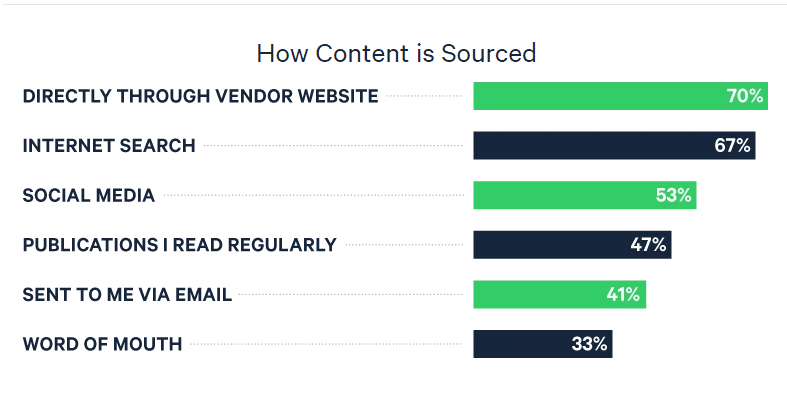
The Ultimate Content Marketing Strategy Template
“Hey there, savvy marketers! Ever felt like you’re throwing darts in the dark when it comes to your content marketing?
You’re not alone. But here’s the kicker: you don’t have to. Using a solid content marketing strategy template can guide your efforts so you can navigate through it. Otherwise, you may be grasping at where to start!
That’s right, I’ve got your back with the ultimate content marketing strategy template. This isn’t just another ‘how-to’ guide; it’s your GPS for navigating the complex landscape of content marketing. So buckle up, because we’re about to turn your content chaos into a well-oiled machine. Let’s dive in!”
Quick Takeaways:
- A content marketing strategy is the roadmap for all your content efforts.
- There are many aspects of a strategy, but they all need to work together to achieve the goals you set.
- Using a template provides an easy way to organize your strategy.
- With a template, you can put the strategy into action much sooner.
🔥 PS – I put together these 10 tips for optimizing your content marketing strategy. Watch Now!
What Is a Content Marketing Strategy?
A content marketing strategy is the guiding document for executing how you’ll use content to meet business goals. It sets the parameters for what you’ll do, how you’ll do it, and where you’ll do it.
Let’s get one thing straight: a content plan is NOT a strategy. It’s like confusing the recipe with the meal. The plan is your ingredient list; the strategy is the culinary genius that turns those ingredients into a Michelin-star dish.
It’s also a living document that will change and evolve as your business, products, and target buyers do.
Let’s take a trip down memory lane. The pandemic year of 2020 was a year that had us all rethinking our game plans, including content marketers. According to the Content Marketing Institute’s B2B report, a whopping 94% of us had to shake things up and pivot our strategies.
Now, here’s the kicker: despite this massive shift, only 43% of organizations actually have their strategies written down. Yeah, you heard that right.
And get this: 70% of organizations are pumping money into content marketing. So, it’s kinda mind-blowing that so many are still winging it without a documented strategy.

Why You Need a Content Marketing Strategy
As noted, it will keep you organized and consistent. However, there’s more to it than just logistics. Content marketing is a way to shape thought leadership and earn trust.
Content marketing isn’t just about churning out articles; it’s about shaping conversations and building a tribe that trusts you. It’s your ticket to becoming the go-to guru in your industry.
Content is pivotal in driving target audiences to your website. The way B2B buyers make purchasing decisions is much different now. The typical B2B buyer consumes 13 pieces of content before making a decision.
Within that 13, 8 will be from the company. They find it most often directly on the website, through search, and social media.

Your company can’t drop the ball on content to get found, which is the leading reason you need a strategy. If you don’t have this foundation, you don’t know critical things like:
- Who your buyer is and what motivates them
- What topic clusters you should create content about
- The types of content you’ll create
- Where you’ll distribute the content
- How you’ll manage content creation and publication
- How you’ll optimize for search engines
- What and how you’ll measure to understand content performance in relation to goals
- And so much more
Without these things clearly spelled out in a strategy, you’re just going to be reactive, no proactive. You’ll be throwing the darts, but they won’t hit the bullseye.
PS – Check out our weekly blog content service to grow your website traffic and leads!
The Benefits of Having a Strategy
If you do all the work to build a strategy, will it pay off? What kind of benefits can you expect?
- Content marketing ROI will be easier to track: A strategy defines how and what you’ll measure to analyze performance continuously.
- Your content will better align with your audience needs: An important part of your strategy will be defining your target audience. When you really know whom you’re targeting, your content will resonate with them and create trust.
- A holistic view of all content efforts is possible: Content sits in lots of buckets — blogs, long-form, website pages, social media, email, etc. When you have a strategy, you can see how all those pieces fit together.
- Consistency in voice and tone: How your brand sounds should be consistent no matter how many content creators you have. A strategy makes this possible.
- You’ll drive more organic traffic: Your digital content strategy will include SEO. When you target the right keywords and write high-quality content, you should see a boost in organic rankings and traffic.
- Distribution won’t be haphazard: Creating the content and publishing it is the first part; distributing it through multiple channels is how you extend reach. A strategy will define your distribution methods. A content strategy agency can help you execute effectively.
- You’ll gain more leads: Content’s primary goal is to generate leads, and it can do that in many ways — blogs, gated content, and more. In fact, companies with blogs average 67% more leads than those that don’t.
- Your brand will earn recognition as an expert: Content with a thought leadership angle isn’t about selling. It’s about educating. The more you do this with your content, the more likely your audience sees you as credible and trusted.
How to Create a Content Marketing Strategy
So, how should you go about creating a content marketing strategy? It’s not a simple endeavor. It’s also not something that only one person develops. All stakeholders should participate in some way.
As a primer, watch this short video from SEMrush before we get into the weeds.
Next, let’s go through the steps and exercises.
Step 1: Define What Content Marketing Means for Your Organization
Content marketing is the consistent publishing of relevant content that drives business outcomes. That’s the general definition, but what does it mean for your company?
In this introduction to your strategy, you’ll be formulating the goals of producing content. Such goals may include:
- Generating more qualified leads
- Boosting credibility and trustworthiness
- Improving brand equity and awareness
- Ranking better on Google
- Supporting sales team efforts
- Driving more traffic to your website
- Building a community
In this section, you also want to define the tactics that will help you achieve these goals — consistent content production, more gated content, optimization of content to rank well, nurturing leads, and mastering amplification.
Lastly, you need to make the connection between content and revenue. This is for the stakeholders that aren’t content marketing astute who make budget decisions.
If you can’t connect the dots for them, they’ll continue to look at you as a cost center, not a revenue generator.
That means you have to track efforts on the backend. For example, if you can attribute traffic and conversions to organic search, it demonstrates that optimized content delivers new customers.
Step 2: Determine Your Content Pillars and Types
Content pillars are the main categories from which all ideas originate. They keep your content creators focused. Once you begin to build your content calendar, tagging pieces with the pillar helps with auditing to see if you have gaps.
You’ll also want to document the types of content you’ll create. There’s more to content marketing than just blogging, which is, of course, critical.
You’ll also have long-form content, case studies, infographics, video, social media posts, webinars, and more.
Step 3: Create Your Buyer Personas
Buyer personas are pivotal to your strategy. You are creating content for them, so you need to know them well. This goes beyond demographics and titles.
You also want to define their pain points, assumptions, challenges, motivations, and objections.
Buyer persona creation should be a group exercise that would include content marketers, product managers, sales, and other SMEs (subject matter experts).
Revisit buyer personas at least annually to refresh them. If something big changes in your industry or company, that’s also a good time to review them.
Step 4: Design Your Content Calendar and Workflows
In this section, you’ll need to identify what your content calendar will look like and where it will live. Check out these content calendar templates for reference.
A content calendar is a living document that provides visibility across all projects. That’s where your workflows are as well. There are many tasks involved to take a content piece from ideation to publication to amplification.
Step 5: Develop a Voice and Tone
Brand voice and tone documents create parameters for content, attributes of the brand’s voice, foundational language, and product language.
Your brand voice should have at least three attributes. For example, one could be conversational. Then you describe it: it’s not formal; slang is okay; it’s benefit-driven, not feature-focused.
Then, you can outline some dos and don’ts. With the example above, a conversational voice doesn’t use complex words and is friendly and personable.
Then, you’ll define parameters around:
- Syntax, structure, and readability (e.g., keep sentences short, use confident statements and not finite ones, and don’t use passive voice)
- Word choice: What do you call your buyers? What language is familiar to them?
- Phrases to avoid: A list of words you shouldn’t use, like cliches
- Blog parameters: Minimum word count, sub-header usage, appropriate CTAs, etc.
- Foundational language: Includes your USP (unique selling proposition), value proposition, and elevator pitch
- Product language: A messaging matrix that’s specific to each product
Step 6: Develop Your SEO Strategy
SEO is critical to content marketing. However, write for people first, Google second!
You’ll want to address:
- Keywords to target and track
- Technical issues that are causing crawling or ranking issues. This will probably include an audit. See the video below from Ahrefs on how to do this.
- SEO best practices for all your website content (e.g., internal links, meta descriptions, using image alt tags, etc.)
- Backlinking opportunities (guest posting, outreach, editorials, etc.)
- Site health and the issues impacting it (e.g., broken links, mixed content issues)
Using a platform to track your SEO efforts is a good idea. You’ll get insights and discover issues immediately. Tracking your rank position is also critical.
If you lose ranking, you’ll want to understand why. Then take remediation steps to improve it.
PS – Check out our latest case study that shows how we helped one company double their leads!
Step 7: Outline Your Distribution Strategy
You’ve got content. Now you need to send it out into the world.
Within distribution, you’ll have several buckets:
- Social media: Define the profiles you’ll use, what you’ll post, how often you’ll post, and how social media engagement ties to revenue.
- Email marketing: What types of emails will you send to distribute content? Newsletters? Long-form content offers? Nurture campaigns?
- Amplification tools: There are many options for amplifying your content, including services like Boca, Converge, GaggleAMP, and Outbrain. If you have the budget and resources, check these out.
- Third-party distribution: This could be paid or organic. For paid, you can use sponsored content opportunities with trusted industry publications. Organic would be working with a partner to create mutually beneficial content.
Here’s a template we use to measure the ROI of various distribution options (paid and organic):

Step 8: Illustrate How Content Marketing Supports Traditional Marketing
Content marketing can complement traditional marketing like trade shows, PR, and product launches.
In this section, you’ll outline how content can contribute to these areas. For example, you can create pre-event blogs about a trade show, promote an exclusive piece of content for registrants, and then deliver that post-show.
Step 9: Identify the Metrics That Matter
How will you determine content marketing ROI? What metrics do you need to measure to discern if you’re meeting your goals? The most crucial content analytics include:
- Traffic to website
- Top pages
- Pageviews: blog pageviews are the most important
- Source referrals to the website: social media, organic search, third-party websites
- Average time on site
- Bounce rates
- Social media engagement (likes, shares, comments, clicks)
- SEO position rankings, visibility, and site health
- Conversions from content marketing efforts
- Email opens and clicks
Here’s the content marketing dashboard template we use:

Choosing a Content Marketing Template
Now that we’ve explained the steps to developing one, you need to put it all together in a way that makes sense for all parties.
Not everyone that views or uses it will be an expert in content marketing. Consider that when reviewing these content marketing templates.
Here is a totally free content marketing worksheet (google sheet) I give away and use with clients in our content marketing strategy workshops.
DivvyHQ
Our tool of choice is DivvyHQ and they have a 30-day content marketing strategy template that offers lots of guidance on building a unique strategy that will support your business goals. It’s 10 steps, but it’s not overwhelming.
Backlinko
Backlinko offers a content marketing template in three formats. It’s fairly simple and doesn’t include all the steps above, but it’s a good starter version.
CoSchedule
CoSchedule offers a more robust template and provides instructions on how to use it. It’s available for download if you complete the form.
ContentCal
ContentCal boasts its template is very flexible, and that’s a good thing. They also offer direction on how to use the template. They even offer you a glimpse of their own strategy to inspire your own.
A Content Marketing Strategy Template in Action
Going through the steps and organizing the template is a great first step for your content marketing efforts. However, you’ll need to put it into action. Implementation can often be a giant hurdle.
That’s where we can help. We can help you develop the strategy and put it into action by being your content creators.
If you are ready to get more traffic to your site with quality content published consistently, check out our Content Builder Service.
Set up a quick consultation, and I’ll send you a free PDF version of my books. Get started today and generate more traffic and leads for your business.







